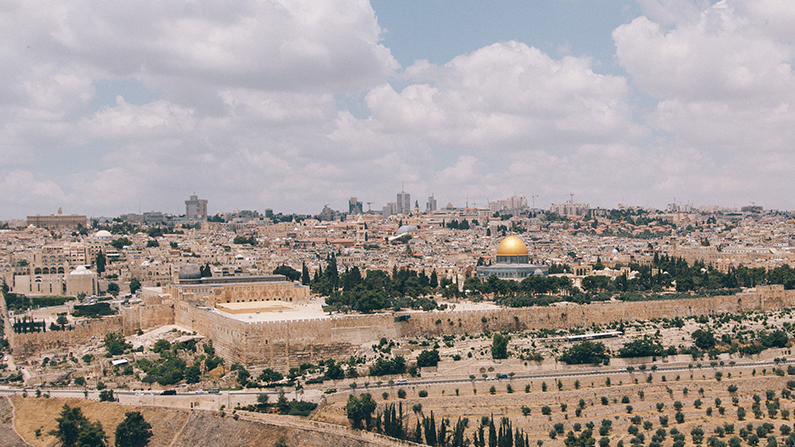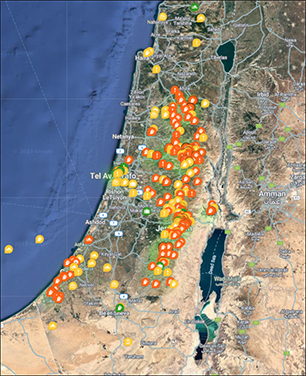Violence in the West Bank

Increasing Violence in the West Bank
Intelligence update March 2023
Since January 2023, Israel and Palestine have been locked in what appears to be an unceasing cycle of deadly incidents and escalation. However, the current situation has not emerged out of a vacuum.
Indeed, both 2021 and then subsequently 2022 were consecutively recorded as being the deadliest in the West Bank for over 15 years. Recent political developments in both the West Bank and Israel have only fueled existing tensions and have contributed to the rising rates of violence.
Many of the tensions and issues underpinning the current volatility are long-standing and well-known; however, the last twelve months have also seen several developments which have further negatively impacted the regional security situation.
Resultingly, it is almost certain that 2023 will be more violent and deadlier than 2022. Indeed, as of February 2023, current trends indicate an increasing tempo of both attacks from Palestinian groups and retaliatory raids and operations from Israeli Defence Forces (IDF).
As such, it seems increasingly likely that the region is now on course to see the outbreak of broader conflict, which in time could be termed the ‘Third Intifada’.
Declining security across Israel and Palestinian Territories
Between 1 January and 10 March 2023, across Israel and the Palestinian Territories there have been 1,169 risk events plotted in Solace Secure, with at least 91 killed. The same period in 2022 saw 618 incidents take place, registering 18 fatalities. This surge in violence at the start of 2023 follows two years of steady deterioration in the regional security environment. For example, in 2022, at least 150 Palestinians and at least 20 Israelis were killed in the West Bank, prompting the United Nations to declare that year the deadliest since the end of the Second Intifada in 2005. The Second Intifada is estimated to have left at least 4,300 dead over a five year period.
The rapidly declining security situation has been sparked by several interrelated factors. Firstly, since March 2022, the northern parts of the West Bank particularly around Nabulus and Jenin, have seen near-daily raids by the Israeli Defence Forces (IDF). These raids have formed the largest IDF operation outside of an official war. This operation is called Operation Break the Wave. Launched in March 2022, Break the Wave was ostensibly designed to halt the emergence of new Palestinian militia groups inside the West Bank. Such groups include the Lions Den, Balata Brigades, Mujahideen Movement, Popular Resistance Movement and the Yabad Brigades. It should be noted that whilst some of these groups have only recently formed in the West Bank, they have been present in Gaza for some time. As such, there is concern that Gaza-based groups are trying to insert themselves, with some success, into the West Bank to further drive instability. Some of these groups also appear to have emerged organically amongst the West Bank’s disillusioned youth, providing further evidence that a significant number of Palestinians now support a new armed struggle. Alongside this, Operation Breaking Dawn was launched to neutralise the threat posed by the Palestinian Islamic Jihad group in Gaza.

Alongside these operations, a new IDF open-fire policy began to be implemented from January 2022, which permitted IDF personnel to use lethal force against Palestinians who throw stones, projectiles and Molotov cocktails. Several other violent and deadly incidents have also taken place which have only contributed to the deterioration of the security environment and a stoking of tensions between Israelis and Palestinians. This includes the resumption of targeted assassinations by the IDF against known militia or terror cell leaders and the first bus bombing in Jerusalem since 2016; a twin bombing in November 2022 which led to 2 deaths and over 22 injuries. Finally, the Palestinian Authority’s (PA) preventative security forces have also escalated arrests of political activists in areas of the West Bank where they have security jurisdiction. This has generated accusations from Palestinians and militant groups that the PA have become increasingly authoritarian, repressive, and collaborationist, akin to a quisling regime.
The contentious issues of homes has also played a key role in driving insecurity in the region. The policy of demolishing Palestinian homes and structures built without permits has continued apace. In January 2023, 39 Palestinian homes, structures and businesses were demolished in East Jerusalem alone, more than a quarter of the entire number of demolitions in 2022. Meanwhile, in the last two years, Israel has continued to expand the size and number of its settlements in the West Bank. Resultingly, thousands of new settlement units have been built in the last two years.
Further to this, in February 2023 the incumbent Israeli government announced plans to build a further 10,000 settlement units and to grant retrospective authorisation and permissions to nine illegally established “settler outposts”. This retrospective authorisation means that they will now be treated on the same basis as all settlements established by the Israeli state. Alongside both the construction and demolition of homes, there have been several notable incidents where Palestinians or Israelis have protested and blockaded the entry and exit to each other’s settlements and neighbourhoods. This includes the ongoing blockade of the Palestinian city of Nablus, which has seen Israeli and Palestinian citizens come into direct conflict.
What is an Intifada?
The First and Second Intifadas, or uprisings, were sustained periods of deadly unrest and violence across Israel and the Palestinian territories characterized by high civilian and military casualties in attacks and incidents. The Second Intifada was particularly marked by gun battles, assassinations, and tank and arial attacks by Israeli forces. Palestinian forces meanwhile engaged in targeted bombings, gun battles, projectile throwing, and rocket attacks. The use of suicide attacks also increased considerably during this period. Any period which eventually becomes known as the Third Intifada is almost certain to see such incidents re-emerge on a regular basis. Intifadas are often named retrospectively, and as such the tempo and type of incidents that occur will be key to determining whether the unrest and violence currently impacting Israel and the West Bank escalates into a Third Intifada.
Political Instability for Israel
Since 2019, Israel has experienced a period of political instability which has seen the country hold five general elections. This volatile period was a direct result of inherent instability in the country’s coalition governments, due to liberal parties refusing to cooperate with Benjamin Netanyahu, whilst the country’s conservative and right-wing parties refused to form a coalition without him or his party, Likud. Netanyahu had become controversial due to his indictment on charges of bribery, fraud, and breach of trust. His refusal to step aside thus created stark divisions in the Israeli political landscape which bisected more traditional cleavages such as left-wing and right-wing. During this period of instability, policies and rhetoric concerning both Palestine and Israeli Arabs both ramped up. This was especially noticeable from the Israeli right and far-right in 2021, when for the first time Israeli Arab parties formed part of a government coalition. This coalition ultimately collapsed, partially as a result of the pressure placed upon it by those on the Israeli right and far-right.
The country’s fifth election was held in November 2022 and saw Netanyahu and his party, Likud, emerge as the largest party in parliament. By December 2022, Likud had managed to form a governing coalition which had 64 seats in the Knesset, thus giving them a working majority of three. The new government is Israel’s most right-wing and ultra-orthodox government since its founding. Alongside Likud, parties in the new government include the ultra-conservative Noam, Otzma Yehudit, and Religious Zionist parties. Noam seeks to roll back LGBT and Palestinian rights, Religious Zionism opposes the ceding of any territory to a future Palestine State and formally supports the annexation of the West Bank, whilst Otzma Yehudit seeks annexation, a one-state solution and a “deeper Jewish identity”.
Consequently, government policy and rhetoric since November 2022 have only further inflamed an already delicate security environment. For example, a visit to the Temple Mount/Al Aqsa compound by National Security Minister and far-right politician, Itamar Ben-Gvir and the blocking of the Jordanian ambassador from the compound both drew protests from Palestinians and unusually, senior leaders in Israel’s ultra-orthodox community. These leaders stated the actions of Ben Gvir simply “goaded the entire world”. Israel has also sought to sanction the PA for going to the International Criminal Court to seek a ruling on the status of the ongoing occupation of the West Bank. These sanctions include retaining tax revenue the Israeli government collects on behalf of the PA, halting Palestinian construction projects, and removing travel privileges from members of the PA. Other recent aspects of government policy also seem expressly designed to only further anger and radicalize Palestinians. These include classifying the flying of the Palestinian flag as an act in support of terror, the stated aim of increasing the pace of demolishing Palestinian homes and structures and the return of capital punishment for those found guilty of killing Israeli citizens in terror attacks.
| Territory | Negligible | Low | Moderate | High | Severe | Total |
| Israel | 0 | 16 | 58 | 21 | 0 | 95 |
| Gaza & West Bank | 0 | 7 | 137 | 337 | 9 | 490 |
| Total | 0 | 23 | 195 | 358 | 9 | 585 |
The new government also has problems within Israel. The country remains deeply split around Netanyahu, and controversial reforms to the judiciary have galvanized those who do not support the current coalition government. These reforms will grant the Knesset the power to override any supreme court ruling with a simple majority vote, see the country’s judiciary selection committee appointed by the government, and remove the judiciary oversight of Israel’s Basic Laws, a series of quasi-constitutional laws. Due to the design of Israel’s political system, the Supreme Court is currently the only check on Israeli government activity, and removing these reforms would effectively give carte blanche to the government from a legislative perspective.
It should also be noted that if these reforms are passed, it would remove the legal jeopardy Netanyahu faces as a result of fraud charges. Already, recently enacted legislation prevents the Court from ordering the resignation of the prime minister if they are deemed unfit to serve, which could prove of critical importance depending on the outcome of Netanyahu’s charges. Consequently, since the proposed reforms were announced in January 2023, most weekends have seen large-scale protests across Israel. The protests in Tel Aviv commonly attract more than 100,000 attendees. The political volatility and polarisation within Israel are such that President Isaac Herzog has stated that the country is “on the brink of constitutional and social collapse”. As of March 2023, the proposed judicial reforms have also led reservists in the IDF air force and intelligence units to refuse to report for duty in protest. This not only highlights how divisive these reforms are, but raises the possibility that the IDF could become politicised and less effective in the maintenance of security in the region.
Increasingly, it is hard to see how the incumbent Israeli coalition government will survive a full term. However, it is equally difficult to see how a sixth election would produce a less volatile political outcome unless Netanyahu were to stand aside, something he has repeatedly ruled out. If he were to stand aside, three distinct pathways would likely emerge. The first is that he may be replaced by a similarly-minded politician allowing the current coalition to persist, thus leading to no change. The second is that he may be replaced by someone different, and the coalition collapses resulting in new elections in which no party can secure a majority, thus returning Israel to electoral instability. The final option would be that a new government emerges, perhaps seeing the return of Naftali Bennett or Yair Lapid to the office of Prime Minister. This scenario would likely see improvements to internal political stability and a softening of rhetoric regarding Palestine. However, given that declines in the security situation were apparent even during both Bennet and Lapid’s time in office, their return to political primacy would be unlikely to dramatically alter the current course of events. There are also fears that the current volatility and judicial reforms will combine to damage Israel’s democratic character, turning it into a more brittle, less-democratic state. Such states are typically more likely to pursue policies which lead to violence and instability. Such a transformation would likely have both domestic and foreign policy implications for the State of Israel. There are also fears that if the judicial reform is passed it would enable extreme elements in Israeli politics to further pursue policies ultimately detrimental to Israeli security, such as annexation, or further strain existing tensions between Israel’s democratic and Jewish character.
Collapsing Legitimacy of Palestinian Government Body: PA
A third major driver of the rise in insecurity across Israel and Palestine has been the multifactorial collapse of legitimacy of the PA. The PA is a Palestinian government body which has exercised control over the West Bank since the Fatah – Hamas spilt in 2006. This collapse in legitimacy has been driven by the actions of both PA members and also of the Israeli government.
Years of economic mismanagement and a recent decline in international financial support mean the PA is facing an acute economic crisis, placing it on the verge of financial collapse. As of 2021, the PA’s budget deficit was estimated to be USD 1.26 billion by the International Monetary Fund (IMF). This is likely to have grown substantially since that estimation, as Israel has further reduced the amount of money that it remits to the PA. Under the terms of the Oslo Accords, Israel collects customs duties on behalf of the PA and remits this monthly to the PA. Increasingly, however, Israel withholds such payments as punishment for PA activity, and also due to the PA’s propensity to pay money to the families of jailed militants. The increasingly acute economic situation has only served to fuel Palestinian discontent with the status quo.
Alongside this economic mismanagement is the fact that the PA, despite being nominally democratic, has not held national elections for at least sixteen years. National elections have been repeatedly postponed due to disputes on whether Palestinians living in Israeli-controlled East Jerusalem will be allowed to vote. Due to the years-long stand-off on this issue, the lack of national elections is increasingly viewed by Palestinians as a ploy by Fatah to remain in power. This is because if elections were held, Fatah would almost certainly be defeated; electoral data from local and municipal elections which have been held indicate Fatah-backed candidates have been consistently defeated, with the victors being independent candidates or those supported by Hamas. Consequently, much of the political capital and legitimacy that the PA and its elected officials from Fatah previously held has been eroded by the continued lack of democratic process.
Further compounding the lack of political legitimacy, and therefore creating the conditions in which political volatility can flourish, is the lack of presidential secession in the PA. The PA’s incumbent President, Mahmoud Abbas, has long been reputed to have health issues, yet no official successor has ever been announced or anointed. The divide between Fatah and Hamas, the lack of elections in Palestine, and the increasing apathy towards the PA from Palestinians all complicate efforts to implement a smooth transition of power within Palestine away from Abbas. As such, the eventual vacancy of the position of president is likely to lead to factional infighting which may only further drive insecurity in Palestine. This may already be beginning to manifest, with several militant groups competing for primacy in conducting operations targeting IDF personnel or symbols of the Israeli state.
The fact that the PA has often cooperated with Israeli and Israeli security forces has further eroded any legitimacy that the organisation may once have had. PA security cooperation with their Israeli counterparts has seen PA security officials repress protests and activity with a level of force similar to that seen in IDF operations. This has led to Palestinians increasingly coming to view the PA and its security apparatus as an arm of the Israeli government that needs to be resisted.
As a consequence of the convergence of all these issues, the legitimacy of the PA has been comprehensively eroded. It has been unable to achieve financial and economic security for Palestinians, whilst its unelected and repressive nature has come to be increasingly vilified by younger Palestinians. Resultingly, a power vacuum has begun to emerge, in which new non-aligned militias are emerging. These included militias and armed groups such as The Lions Den, and others which Israel initially launched Operation Break The Wave to try and disrupt. Given how little legitimacy the PA retains amongst Palestinians, the ageing nature of President Abbas, the lack of a clear successor, and the increasing percentage of Palestinians who support armed groups, it is unclear how the PA in its current form will be able to maintain security in Palestine. Indeed, there is a realistic probability that with the death of Abbas, a fight for control over the PA and the wider West Bank could be the trigger for a round of deadly intra-Palestinian armed conflict.
External Actors Causing Detrimental Security Situation in Israel and Palestinian Territories.
Whilst the three major internal issues which have contributed to the contemporary regional risk profile have been explored, there are two external factors which also have a detrimental impact on the domestic security situation in Israel and the Palestinian Territories. The first concerns the activities of Iran and its proxies such as Hezbollah, Palestinian Islamic Jihad (PIJ), Hamas, and the Popular Front Liberation of Palestine (PFLP).
Domestically, Iran is currently undergoing a period of turmoil. The country has seen mass civil unrest since September 2022 and more recently a spate of chemical attacks on girls’ schools. To divert attention from domestic problems, the Iranian government may seek to create a series of distractions elsewhere within the region, particularly in Israel and Palestine. Such distractions would likely include the facilitation of rocket attacks or a series of small attacks on settlers or IDF forces in the West Bank. These would undoubtedly generate a retaliatory response from the Israelis, if Iranian involvement was proven. In March 2023, it was reported that representatives from Iranian-backed Lebanese militant group Hezbollah had met with both Hamas and PIJ in Damascus. Consequently, it is increasingly likely that these groups may seek to work together, or at least cooperate logistically, as was apparently the case for a recent attack at Megiddo Junction in Israel in which the attacker reputedly crossed into Israel from Hezbollah-controlled territory in southern Lebanon. Further supporting the assessment of Hezbollah involvement is the claim that the device used in this attack was similar to those used to attack IDF forces in southern Lebanon. The attack was later claimed by a network calling itself “the Galilee Forces – the Lone Wolves”. Interestingly, videos posted to the group’s Telegram channel used terminology reportedly associated with Hezbollah operations, alongside images of critical Israeli national infrastructure listed as possible attack targets.
The other way Iran could contribute to a further decline in the security situation in the region is through their nuclear programme. Recent revelations from the International Atomic Energy Agency (IAEA) that they had found evidence of uranium enriched to above 80 percent, close to weapons-grade enrichment levels, will likely have sparked discussions in the Israeli security apparatus about how best to prevent Iran from developing a functional nuclear weapons programme. Previously, Israel has targeted the Iranian nuclear programme with destructive cyber attacks, drone and missile strikes, and targeted assassinations. As of February 2023, Israel officials have stated they are ready to resume striking targets in Iran if necessary. If such strikes were to occur, Iran would likely retaliate in kind. Iran has previously not only targeted infrastructure and individuals within Israel but has also targeted Israeli assets and officials outside of the region. In both scenarios, Iranian-aligned Palestinian proxies would likely play a large role in any Iranian retaliation which takes place within Israel or Palestine.
The second external factor concerns the presence of the Islamic State (IS) group. Israeli authorities apprehended a suspect in December 2022 for the Jerusalem bus bombings who was associated with IS. Since its inception, IS have called for attacks against both Jews and Israel. The publication of an article entitled “kill the Jews” and a second praising the perpetrator of the Jerusalem bus bombings in February 2023 indicate that the group is actively seeking to generate IS-aligned attacks within Israel. Within the article entitled “Kill The Jews”, IS write that they urge the targeting of “Jewish neighbourhoods and synagogues scattered in Europe and other countries…so kill[ing] the Jews by every means”
IS already claim to have inspired some small-scale attacks in Israel and Palestine and if there was a sudden uptick in the number of attacks linked to IS in the region, it could indicate a temporary shift in IS operational preferences towards Israel and perhaps away from Europe. IS attacks are more likely to be conducted by lone actors, without any supporting cells or group planning, which makes them harder for security services to disrupt. It also lends them a different profile to attacks perpetrated in the name of Palestine by the constellation of active Palestinian militias. Further to this, a shift in IS preferences towards Israel would indicate that the security situation has declined to a point where they feel that they can actively exploit the situation. An IS operational presence in Israel would very likely manifest as an increase in the number of lethal attacks conducted by individual actors, which could include knife attacks and vehicle ramming, but may also include more sophisticated attack methodologies such as bombings and ambushes. An additional differentiator includes that IS are also more likely to prioritise attacks in Tel Aviv or Jerusalem then in urban centres throughout the West Bank. Inserting operational IS networks into Israel would almost certainly complicate domestic security provision, with IDF and police forces already engaged in tackling the constellation of Palestinian militant groups, which in turn would place increasing strain on the declining security situation in Israel.
Risk Forecast for Israel and Palestinian Territories
The confluence of the pre-existing decline in security alongside issues with Israeli and Palestinian governance respectively mean that violence in the region will almost certainly surpass levels of violence witnessed in both 2021 and 2022.
In the West Bank, the lack of legitimacy of the PA has led to the direct emergence of new armed groups which Israel, despite Operation Break the Wave, has failed to disrupt. These armed groups also have the significant backing of many rank-and-file Palestinians, which is a further sign that Palestinians have very likely lost faith in peaceful engagement with Israel.
In Israel, the rise of the ultra-religious within its political system and the proposed judicial reforms raises the possibility that in time it may evolve from a modern, dynamic, liberal democracy to a potentially illiberal, non-democratic, religious state. Even if this is averted in the short term, this scenario will remain an ever present threat due to population growth and growing support for far-right political parties. It is significant that Israel’s ultra-orthodox and conservative population, which is currently around 12 percent of the total Israeli population, is forecast to comprise at least one-third by 2065. Already, ultra-orthodox and conservative parties can win a quarter of the votes in general elections, and as such their vote share is only likely to increase in line with population growth estimates.
At the time of writing, the ongoing cycle of escalation and political volatility has not yet broken outside of established norms and patterns of behaviour for the region. The rise of new armed groups and radically far-right governments have both further inflamed the situation but have not yet precipitated the emergence of wider conflict in the region. In a bid to calm the situation, it was announced that both Israel and Palestinian officials had agreed to establish a joint mechanism to curb violence and incitement ahead of Ramadan and Easter, given the holy significance of sites in Jerusalem during this period. Alongside this, Israel has also pledged to stop discussions around building new settlement units for four months. These pledges were made after multilateral talks hosted in Egypt, at which Israeli, Palestinian, United States, Egyptian and Jordanian officials were present. Details regarding this mechanism are not yet fully understood, whilst similar pledges to curb violence failed to lead to on-the-ground results after a similar meeting, also in Egypt, in February 2023. As a consequence, it is highly unlikely that this new pledge will lead to a notable short term decrease in the number of incidents across Israel and Palestine.
The Islamic holy month of Ramadan is almost certain to generate heightened tensions across Israel and Palestine, especially on Fridays after the Muslim call to prayer and the daily Iftar meal. There will likely be a greater security presence than normal in East Jerusalem and around key holy sites including Temple Mount/Al Aqsa and areas such as the Mount of Olives and the Garden of Gethsemane. Indeed, the confluence of pre-existing tensions and the imminent religious periods of Ramadan (22 March – 21 April), Passover (5 April – 13 April) and Easter (29 March – 12 April) indicates a realistic possibility that a regional terror group may seek to conduct a mass casualty terror attack in Israel in the coming weeks. Indeed, the persistence of security incidents and political volatility in both Israel and Palestine means that it is now a matter of when, and not if, a watershed incident occurs. This may be a terror or militant attack or large-scale IDF operation, it could even include unilateral moves towards annexation by the current Israeli government. Regardless, without significant international mediation or an unlikely shift in the Israeli political landscape, the security situation in Israel and the Palestinian Territories is almost certain to remain volatile into the longer term.
More on Israel and Palestine
Israel-Hamas War 2023
With the incursion into southern Israel by the Gaza-based militant group Hamas over the weekend of 7 and 8 October, this eventuality became a reality, and the region is now on the precipice of a protracted and deadly conflict. Such a conflict will undoubtedly have significant ramifications for those operating in the region.
Israel’s Military Strategy and Biden’s Visit
Iran has warned that its proxy forces will conduct “pre-emptive action” in response to Israel’s retaliatory strikes on Gaza, which will invariably include the use of Hezbollah forces. However, it is unlikely that Hezbollah will conduct any major attacks with President Biden in Israel for fear of a major US retaliation.
Israel-Hamas Conflict: Risks to Journalists and Media Crews
The Israel-Hamas conflict has presented numerous new challenges to journalists within Gaza and Israel, including severe physical risk and new measures regarding censorship. According to the Committee to Protect Journalists (CPJ), at least 37 journalists reporting from within Gaza have already been killed and dozens more injured.
Safegurd your journey with Solace Global
Security Services for Remote and High Risk Areas
We manage the full security lifecycle, from initial security strategy, protection on-the-ground and ongoing overwatch, with advanced risk management software to support compliance and reporting.

Solace Secure: Travel risk management software
Give your people peace of mind when they travel for work, so they remain focused on the job at hand. We mitigate risks, manage incidents if they occur, and support your people with security advice or help in a crisis. With Solace Secure you have everything you need to provide safe passage on a global scale.

Enhanced Monitoring in High-Risk or Remote Locations
An extra layer of security support can be added with our overwatch monitoring tool on Solace Secure. Our crisis response team support your travel policy protocols and keep eyes on travelling employees check in’s. Should anything go amiss, we can begin response procedures immediately.

Speak to a risk management specialist
Our team of intelligence analysts and high-risk location specialists are on hand to help organisations operating in the Middle East.